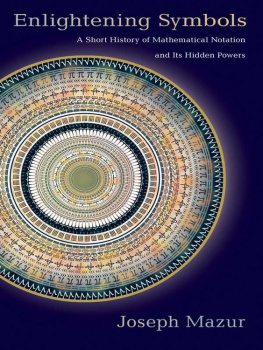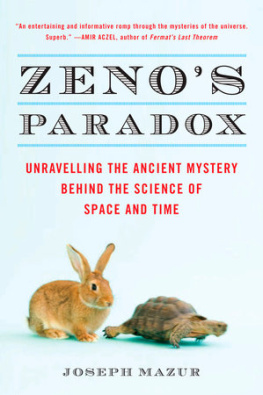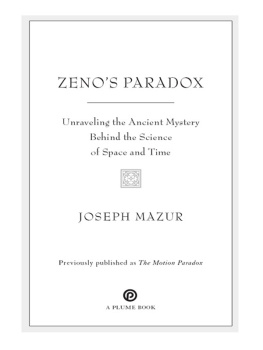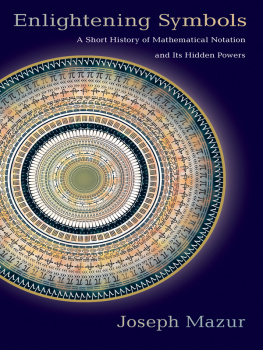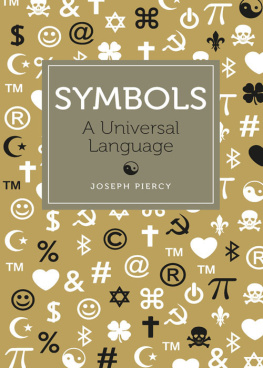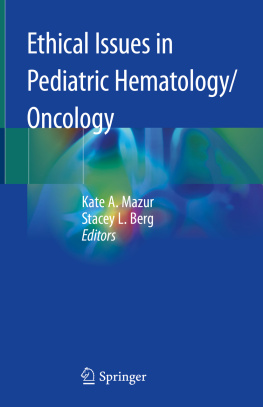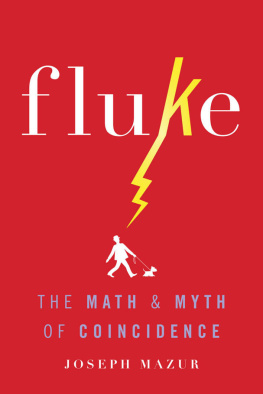Joseph Mazur - Enlightening Symbols
Here you can read online Joseph Mazur - Enlightening Symbols full text of the book (entire story) in english for free. Download pdf and epub, get meaning, cover and reviews about this ebook. year: 2014, publisher: Princeton University Press, genre: Science fiction. Description of the work, (preface) as well as reviews are available. Best literature library LitArk.com created for fans of good reading and offers a wide selection of genres:
Romance novel
Science fiction
Adventure
Detective
Science
History
Home and family
Prose
Art
Politics
Computer
Non-fiction
Religion
Business
Children
Humor
Choose a favorite category and find really read worthwhile books. Enjoy immersion in the world of imagination, feel the emotions of the characters or learn something new for yourself, make an fascinating discovery.
- Book:Enlightening Symbols
- Author:
- Publisher:Princeton University Press
- Genre:
- Year:2014
- Rating:3 / 5
- Favourites:Add to favourites
- Your mark:
- 60
- 1
- 2
- 3
- 4
- 5
Enlightening Symbols: summary, description and annotation
We offer to read an annotation, description, summary or preface (depends on what the author of the book "Enlightening Symbols" wrote himself). If you haven't found the necessary information about the book — write in the comments, we will try to find it.
Enlightening Symbols — read online for free the complete book (whole text) full work
Below is the text of the book, divided by pages. System saving the place of the last page read, allows you to conveniently read the book "Enlightening Symbols" online for free, without having to search again every time where you left off. Put a bookmark, and you can go to the page where you finished reading at any time.
Font size:
Interval:
Bookmark:
Enlightening Symbols
Also by Joseph Mazur
Euclid in the Rainforest: Discovering Universal Truth in Logic and Math (2006)
Zenos Paradox: Unraveling the Ancient Mystery behind the Science of Space and Time (2007)
Whats Luck Got to Do with It? The History, Mathematics, and Psychology of the Gamblers Illusion (2010)
Edited
Number: The Language of Science (2007)
Enlightening Symbols
A Short History of Mathematical Notation and Its Hidden Powers

Joseph Mazur
Princeton University Press
Princeton and Oxford
Copyright 2014 by Joseph Mazur
Requests for permission to reproduce material from this work should be sent to Permissions, Princeton University Press
Published by Princeton University Press, 41 William Street,
Princeton, New Jersey 08540
In the United Kingdom: Princeton University Press, 6 Oxford Street,
Woodstock, Oxfordshire OX20 1TW
press.princeton.edu
All Rights Reserved
Library of Congress Cataloging-in-Publication Data
Mazur, Joseph.
Enlightening symbols : a short history of mathematical notation and its hidden powers / Joseph Mazur.
pages cm
Includes bibliographical references and index.
ISBN 978-0-691-15463-3 (hardcover : alk. paper) 1. Mathematical notationHistory. I. Title.
QA41.M39 2014
510.148dc23
2013028571
British Library Cataloging-in-Publication Data is available
This book has been composed in Minion and Candida
Printed on acid-free paper.
Printed in the United States of America
1 3 5 7 9 10 8 6 4 2
To my big brother, Barry, who taught me from 0
Contents
Introduction
A mathematician, a musician, and a psychologist walked into a bar
Several years ago, before I had any thoughts of writing a book on the history of symbols, I had a conversation with a few colleagues at the Cava Turacciolo, a little wine bar in the village of Bellagio on Lake Como. The psychologist declared that symbols had been around long before humans had a verbal language, and that they are at the roots of the most basic and primitive thoughts. The musician pointed out that modern musical notation is mostly attributed to one Benedictine monk Guido dArezzo, who lived at the turn of the first millennium, but that a more primitive form of symbol notation goes almost as far back as Phoenician writing. I, the mathematician, astonished my friends by revealing that, other than numerals, mathematical symbolseven algebraic equationsare relatively recent creations, and that almost all mathematical expressions were rhetorical before the end of the fifteenth century.
What?! the psychologist snapped. What about multiplication? You mean to tell us that there was no symbol for times?
Not before the sixteenthmaybe even seventeenth century.
And equality? What about equals? the musician asked.
Not beforeohthe sixteenth century.
But surely Euclid must have had a symbol for addition, said the psychologist.
What about the Pythagorean theorem, that thing about adding the squares of the sides of a right triangle?
Nope, no symbol for plus before the twelfth century!
A contemplative silence followed as we sniffed and sipped expensive Barolo.
As it turned out, I was not correct. And far, far back in the eighteenth century BC, the Egyptians had their hieroglyphical indications of addition and subtraction in glyphs of men running toward or away from amounts to be respectively added or subtracted. And from time to time, writers of mathematical texts had ventured into symbolic expression. So there are instances when they experimented with graphic marks to represent words or even whole phrases. The Bakhshl manuscript of the second century BC records negative numbers indicated by a symbol that looks like our plus sign. In the third century, Diophantus of Alexandria used a Greek letter to designate the unknown and an arrow-like figure pointing upward to indicate subtraction. In the seventh century, the Indian mathematician Brahmagupta used a small black dot to introduce the new number we now call zero. And symbols were timidly beginning to find their way into mathematics by the second half of the fifteenth century. Of course, for ages, there have been the symbols that we use to designate whole positive numbers.
That night at the enoteca, I didnt know that my estimate for the adoption of symbols was premature by several centuries. Sure, Diophantus in the third century had his few designations; however, before the twelfth century, symbols were not used for operational manipulation at the symbolic levelnot, that is, for purely symbolic operations on equations. Perhaps I should have pushed the edge of astonishment to claim, correctly, that most mathematical expressions were rhetorical before the sixteenth century.
Ever since that conversation, I have found that most people are amazed to learn that mathematics notation did not become really symbolic before the sixteenth century. We must also wonder: What was gained by algebra taking on a symbolic form? What was lost?
Traced to their roots, symbols are a means of perceiving, recognizing, and creating meaning out of patterns and configurations drawn from material appearance or communication.
The word symbol comes from the Greek word for token, or token of identity, which is a combination of two word-roots, sum (together) and the verb ballo (to throw). A more relaxed interpretation would be to put together. Its etymology comes from an ancient way of proving ones identity or ones relationship to another. A stick or bone would be broken in two, and each person in the relationship would be given one piece. To verify the relationship, the pieces would have to fit together perfectly.
On a deeper level, the word symbol suggests that, when the familiar is thrown together with the unfamiliar, something new is created. Or, to put it another way, when an unconscious idea fits a conscious one, a new meaning emerges. The symbol is exactly that: meaning derived from connections of conscious and unconscious thoughts.
Can mathematical symbols do that? Are they meant to do that? Perhaps there should be a distinction between symbols and notation. Notations come from shorthand, abbreviations of terms. If symbols are notations that provide us with subconscious thoughts, consider +. Alone, it is a notation, born simply from the shorthand for the Latin word et. Yes, it comes from the t in et. We find it in 1489 when Johannes Widmann wrote Behende und hubsche Rechenung auff allen Kauffmanscha (Nimble and neat calculation in all trades). It was meant to denote a mathematical operation as well as the word and.
Used in an arithmetic statement such as 2 + 3 = 5, the + merely tells us that 2 and 3 more make 5. But in the context of an algebraic statement such as x2 + 2xy + y2 it generally means more than just x2 and 2xy and y2. The mathematician sees the +s as the glue to form the perfect square (x + y)2. Now surely the same mathematician would just as well see the and as the glue. Perhaps it may take a few more seconds to recognize the perfect square, but familiar symbols habitually provide useful associations when we are looking at one object while knowing that it has another useful form.
A purist approach would be to distinguish symbolic representation from simple notation. I have a more generous slant; numerals and all nonliteral operational notation are different, but still considered symbols, for they represent things that they do not resemble.
Read the statement 2 + 3 = 5 again. It is a complete sentence in mathematics, with nouns, a conjunction, and a verb. It took you about a second to read it and continue on. Unaware of your fact-checking processes, you believe it for many reasons, starting from what you were told as a young child and ending with a mountain of corroborating evidence from years of experience. You didnt have to consciously search through your mental library of truthful facts to
Next pageFont size:
Interval:
Bookmark:
Similar books «Enlightening Symbols»
Look at similar books to Enlightening Symbols. We have selected literature similar in name and meaning in the hope of providing readers with more options to find new, interesting, not yet read works.
Discussion, reviews of the book Enlightening Symbols and just readers' own opinions. Leave your comments, write what you think about the work, its meaning or the main characters. Specify what exactly you liked and what you didn't like, and why you think so.

